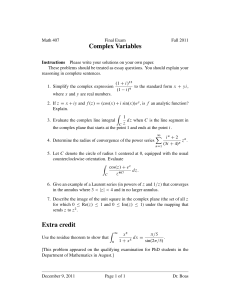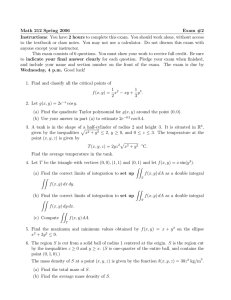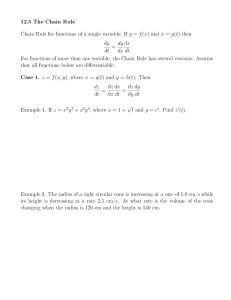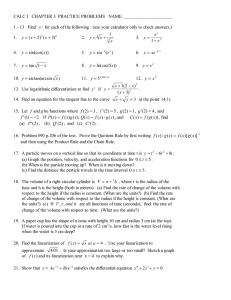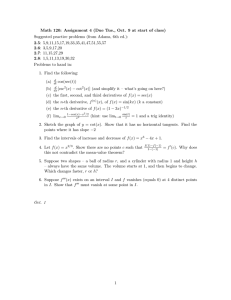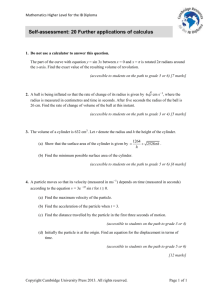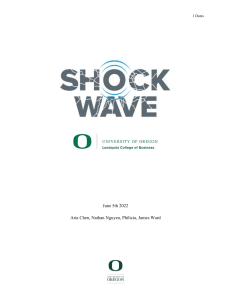Math 1210-1 HW 7
advertisement
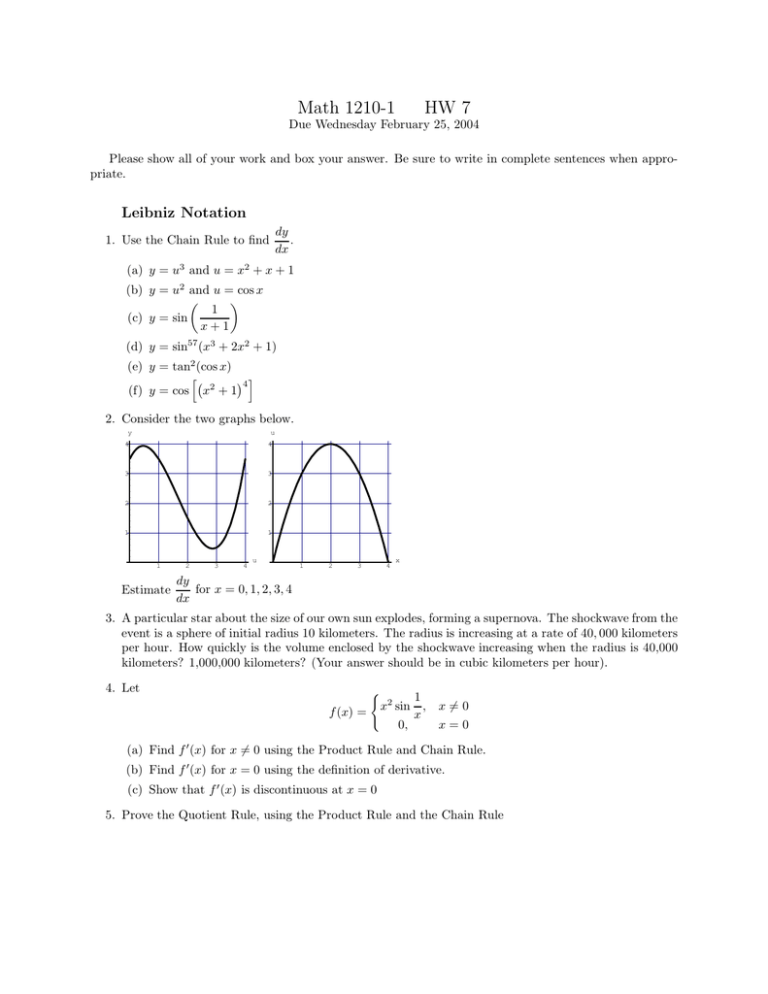
Math 1210-1 HW 7 Due Wednesday February 25, 2004 Please show all of your work and box your answer. Be sure to write in complete sentences when appropriate. Leibniz Notation dy . dx 1. Use the Chain Rule to find (a) y = u3 and u = x2 + x + 1 (b) y = u2 and u = cos x 1 (c) y = sin x+1 (d) y = sin57 (x3 + 2x2 + 1) (e) y = tan2 (cos x) h 4 i (f) y = cos x2 + 1 2. Consider the two graphs below. y u 4 4 3 3 2 2 1 1 u 1 Estimate 2 3 4 x 1 2 4 3 dy for x = 0, 1, 2, 3, 4 dx 3. A particular star about the size of our own sun explodes, forming a supernova. The shockwave from the event is a sphere of initial radius 10 kilometers. The radius is increasing at a rate of 40, 000 kilometers per hour. How quickly is the volume enclosed by the shockwave increasing when the radius is 40,000 kilometers? 1,000,000 kilometers? (Your answer should be in cubic kilometers per hour). 4. Let f (x) = ( 1 x2 sin , x 6= 0 x 0, x=0 (a) Find f ′ (x) for x 6= 0 using the Product Rule and Chain Rule. (b) Find f ′ (x) for x = 0 using the definition of derivative. (c) Show that f ′ (x) is discontinuous at x = 0 5. Prove the Quotient Rule, using the Product Rule and the Chain Rule Higher-Order Derivatives 6. Find d3 y dx3 (a) y = x3 + 4x4 + 3x + 5 (b) y = x2 + 1 (c) y = cos(3x) (d) y = sin(x2 ) 1 (e) y = 2 x +1 7. Suppose a particle is moving horizontally along a line with position from the origin given by s = 3t3 − 5t2 + t + 1 where s is the directed distance in meters and t is the time in seconds. (a) What are v(t) and a(t) the speed and acceleration of the particle at time t? (b) When is the particle moving toward the right (increasing s)? (c) When is it moving toward the left (decreasing s)? (d) When is the particle slowing down? (e) Draw a picture to illustrate the motion of this particle. Hint: Use two dimensions; one for s and one for t. label interesting parts of your illustration. 8. A ball is thrown directly upwards. Its height in meters s above the ground t seconds later is given by s = 20t − 5t2 . (a) What is the initial speed of the ball? (b) When does it reach its maximum height? (c) What is the maximum height attained? (d) What is the speed of the ball and in which direction is it travelling at t = 1 second? (e) When does the ball hit the ground? (f) What is the speed of the ball immediately before it hits the ground? Implicit Differentiation 9. Find dy by implicit differentiation. dx (a) x2 + y 2 = 1 (b) xy = 1 (c) x2 y 2 = x + 1 (d) cos(xy) + sin(xy) = (e) x2 y + y 2 x = 0 √ 2 10. For each of the equations in Problem 9 above, we give a point (x, y) which satisfies the equation. Find the equation of the tangent line to the corresponding curve at that point. √ √ ! 2 2 (a) − , 2 2 1 ,4 (b) 4 √ (c) (1, 2) π ,1 (d) 4 (e) (−1, 1) 11. Find dy . dx (a) y = √ x − x9/5 (b) y = x−2/3 1 (c) y = √ 2 x +1 12. The curve given by x2 + y 2 = 25 is a circle of radius 5. Find y ′′ at (4, 3) using implicit diffentiation twice. 13. Suppose s3 t + s2 t2 = 1. Find ds dt and . dt ds Related Rates 14. Each edge of a growing cube is increasing at a rate of 5 centimeters per second. How fast is the volume of the cube increasing when an edge is 20 cm long? How fast is the surface area increasing when an edge is 20 cm long? 15. A circular metal disk is heated and expands. Suppose the radius increases at a rate of 1 millimeter per second. How fast is the area of the disk expanding when its radius is 10 cm? 16. Refer to Problem 3. Suppose that the radius R in kilometers of the shockwave t hours after the event is given by R(t) = 10 + 40000t − 10t2 . (a) What is the initial radius of the shockwave? (b) What is the initial speed of the shockwave? (c) What is the initial volume enclosed by the shockwave? (d) How fast is the volume enclosed by the shockwave growing initially? (e) What is the speed of the shockwave at time t = 1 hour? (f) How fast is the volume enclosed by the shockwave growing at time t = 1 hour? (g) What is the speed of the shockwave at time t = 24 hours (1 day)? (h) How fast is the volume enclosed by the shockwave growing at t = 24 hours? (i) What is the volume of the shockwave at t = 24 hours?

